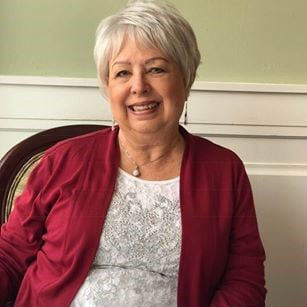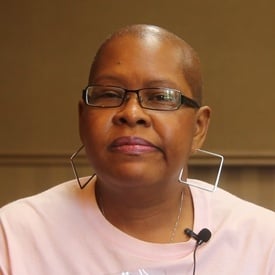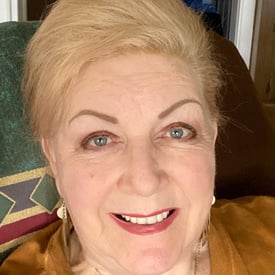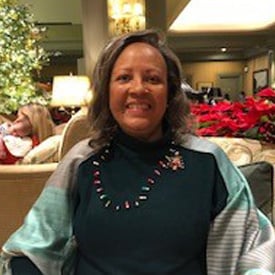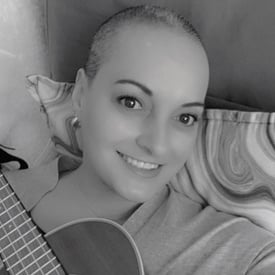Chris J-LPP/FFA

I think it’s okay to feel sad and mad, angry and sometimes depressed. I think we need to validate those feelings for ourselves, because the world doesn’t yet appreciate the full impact of skin diseases.
It was more than ten years ago, when I first noticed some changes in my hair. It seemed like I was losing my sideburns and the far-ends of my eyebrows were disappearing. I also had some itchy and burning spots on parts of my scalp and neck. I had asked my family doctor, consulted Dr. Google and wrote it off to peri-menopausal hair loss or maybe I had low thyroid. So, I started focusing on strengthening my endocrine system. Even so, my hair and eyebrows kept thinning, the itching on my scalp and neck nape persisted, and my sideburns were rapidly disappearing. My life was stressful at the time, so I then wrote it off as stress-related hair loss and assumed it would grow back when things calmed down. I had started working in patient support and advocacy in Canada a few years earlier. I was already living with a handful of skin conditions, so when looking back, it’s odd that I didn’t take my own advice at the time. For patients who called into my office for support, I’d always recommend, “Go see your dermatologist and advocate for yourself. Don’t quit until you know what you’ve got and have a treatment plan that works for you.”
After having my head in the sand for far too long, I knew I needed some answers. While I was attending the American Academy of Dermatology convention for work, I ran into a very well-known Canadian expert in hair loss, Dr. Jerry Shapiro, walking in the convention hall. I knew Dr. Shapiro already through some other work I’d done a few years prior and asked him to look at what was happening on my scalp. I am so grateful that Dr. Shapiro found the time in his busy schedule to examine my symptoms, because the next few phrases out of his mouth sent me on a tailspin. He said, “It looks like you have FFA, or Frontal Fibrosing Alopecia. When you get back home, you need to see a dermatologist immediately. You are having a follicular emergency that needs to be addressed right away.”
Yikes. There it was. I was standing in the convention hall with waves of concern and lots of unanswered questions swirling around in my head. So, like most people today, I jumped on the internet and immediately started doing some research. The more I read and saw, the more I began to panic. I guess you could say I was “emotionally distraught” for the next few weeks. When I finally got into a dermatologist’s office back at home, I was faced with more disappointing news. First, the dermatologist didn’t want to do a biopsy. And then in a very sad, melancholy voice said, “You have classic FFA and there is nothing that can be done about it. Your hair is never going to come back and its very likely you will lose much more.”
Talk about a slap in the face. I left the office and sat in my car weeping uncontrollably. I had a lot going on in my life at the time, both physically and emotionally, and I thought ‘’Now I have this too? Why did this happen to me?”
Once I cleared my head, I knew I would never go back to see that doctor, but I had to find another dermatologist for a diagnostic biopsy and one that would work with me. I hit the internet again and found SAF, signed up to become a member, and learned about my options. I started to understand what I was facing and was able to get in to see another dermatologist whom I knew and respected. While she wasn’t a specialist in hair diseases, she was a widely-respected physician in Canada. Again, I realized that I wasn’t following my own professional advice, which was to make sure (as much as possible) that you are being cared for by doctors who attend and present at scientific conferences, because they will know what’s happening on the leading edge of science and what works… or doesn’t.
So, I tracked down one of the few dermatologists in Canada who specializes in diseases of the hair and drove 5 hours for an appointment with him. He spent over an hour with me, rocked my world, and gave me the first of what would be many series of injections in my scalp. He recommended an aggressive schedule of injections and a change of medication. At this same time, I switched to a local dermatologist near my home who agreed to collaborate with this hair specialist and would be able to treat me locally for the monthly injections. Because there is a dire shortage of dermatologists in general, this was a big ask and I’m very lucky to have this coordinated team.
Later that year I attended my first SAF conference, in Boston, and was lovingly embraced into the cicatricial alopecia community. I learned so much from the scientific sessions, and from the large group of patients there. I met two women from eastern Canada and together we vowed to start a Canadian support group – which we did! “CASA- All Fired Up,” meets in Toronto but often audio- conferences people in who live further away.
I tried various treatments but have been afraid of trying the heavier duty drugs like Cellcept or Methotrexate. That’s just me and reflects my personal risk tolerance. Over the years I’ve lost almost two inches of hairline, and my sideburns are fully gone. I am bald along the sides and over the ears. I used to have a ton of hair, all of it fine and straight. I used to have peach fuzz all over my body. I now also have weird bumps on my face, where the peach fuzz used to be. Most of my body hair is gone. At least, I don’t have to bother shaving my legs!
Currently, I take Dutasteride several times a week, spread Clobetasol lotion (a liquid) on the inflamed areas of my scalp most nights and get steroid injections once a month. I’m trying naltrexone daily to address the pain and itch on my scalp and am beginning to feel some change there. I am still shedding, and my scalp is still actively red. So, this isn’t working entirely.
I have other autoimmune, inflammatory conditions and I can’t help but think they are all connected in some way. I have another lichen condition, beyond LPP – I’d love to hear how many of us are struggling with potentially-connected conditions.
Emotionally, I’m up and down. I avoid the mirror. I avoid showering for as long as possible (within reason!) because I don’t want to be faced with my hair loss. I often feel ugly. I have some hairpieces and yet when I wear them, I feel like I am being false somehow…even though I KNOW they are like make-up. I get angry that I have to spend money and time on this.
Here’s the thing… we know there is social stigma associated with having a dermatological condition like cicatricial alopecia. We know that those of us with them often feel shame. And yet, those around us (and bizarrely even we, ourselves) tend to minimize any concerns or negative feelings we may have. A family member, upon hearing my news years ago, cheerfully said,” Well, look at the bright side, you can wear a different color wig every day!” Another said, “At least you’re not going to die from this.” So, I am made to feel shame about feeling bad, or vain that I care that I look different in a culture focused on beauty.
I think it’s okay to feel sad and mad, angry and sometimes depressed. I think we need to validate those feelings for ourselves, because the world doesn’t yet appreciate the full impact of skin diseases. I believe that we all cope in different ways – some by avoiding living daily in the disease, some by taking charge of it and some who swing back and forth. I’d love to see us all eliminate the shame we feel.
I want to see a safe effective treatment for our alopecia in my lifetime. I’m now taking my own advice (finally) and doing something about it. If you managed to read this far and also want to spare our children and grandchildren, reach out to me directly or through SAF. We’ve been silent and hidden in the shadows for far too long.




